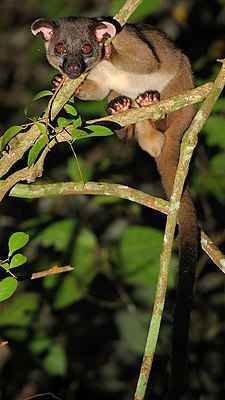Strip roller
| Strip roller | ||||||||||||
|---|---|---|---|---|---|---|---|---|---|---|---|---|

Strip scooter in Khao Yai National Park in Thailand. |
||||||||||||
| Systematics | ||||||||||||
|
||||||||||||
| Scientific name of the genus | ||||||||||||
| Arctogalidia | ||||||||||||
| Merriam , 1897 | ||||||||||||
| Scientific name of the species | ||||||||||||
| Arctogalidia trivirgata | ||||||||||||
| ( Gray , 1832) |
The striped roller ( Arctogalidia trivirgata ) is a species of predator from the family of the stealthy cats (Viverridae).
description
The body structure of the strip roller corresponds with the elongated body, the long tail and the short legs that of many other crawling cats. Their fur is colored orange-brown to gray-brown on the upper side. The name-giving feature are the three dark brown or black longitudinal stripes along the back, of which only the middle one is clearly visible. The underside is white-gray, the head gray. Another feature is a white stripe that runs from the pointed snout to the forehead. The animals reach a head body length of 43 to 53 centimeters, a tail length of 51 to 66 centimeters and a weight of 2 to 2.5 kilograms. The teeth are small, rounded and set well apart.
- Tooth formula : I 3/3, C 1/1, P 4/4, M 2/2 = 40.
Distribution area and habitat
Striped scooters live in Southeast Asia , their range extends from the extreme east of India via Myanmar , Thailand and Indochina to the Indonesian islands of Sumatra , Borneo and Java . Their habitat are dense forests, predominantly tropical rainforests .
Way of life
Striped rollers are nocturnal, mainly tree-dwelling animals. They are good at climbing and jumping from branch to branch. They use high branches as resting places, sometimes also the nests of other animals, for example the giant squirrels . Like most crawling cats, they live solitary.
Striped rollers are omnivores that feed on small mammals (e.g. squirrels ), birds , frogs , insects and fruits.
The female can give birth to offspring twice a year, the gestation period is around 45 days and the average litter size is three young.
Systematics
The strip roller was first scientifically described in 1832 by the British zoologist John Edward Gray under the name Paradoxurus trivirgata and thus assigned to the musangs ( Paradoxurus ). In 1897, the American zoologist Clinton Hart Merriam introduced the genus Arctogalidia for the species. In the course of time, up to 17 strip roller taxa were newly described and most of them withdrawn. In the Handbook of the Mammals of the World , a standard work on mammalogy , three subspecies are recognized:
- Arctogalidia trivirgata trivirgata , Malay Peninsula south of the Isthmus of Kra , Sumatra, Borneo and smaller islands of western Indonesia
- Arctogalidia trivirgata leuwris , Northeast India, Myanmar, Thailand, Indochina, Malay Peninsula north of the Isthmus of Kra
- Arctogalidia trivirgata trilineata , western Java
Within the family of the crawling cats, the striped roller belongs to the subfamily of the palm roller (Paradoxurinae).
A DNA comparison published in 2015 showed that the strip roller population on Borneo is genetically so different from all other strip rollers (5.7% of the cytochrome b DNA) that a status as an independent species is to be advocated. For the time being, however, the authors are foregoing a formal revision of the genus Arctogalidia until further data, including those from the core DNA, are available. The species name Arctogalidia stigmatica , which was coined by the Dutch zoologist Coenraad Jacob Temminck in 1853, would be available for the Borneo strip roller . The strip rollers from Groß-Natuna could also represent an independent species. They are smaller, have a darker fur, they lack the dark stripes on their backs and they also differ morphologically from the other stripe rollers.
threat
Strip scooters have a large distribution area, the main threat, as with many other inhabitants of the Southeast Asian forests, is the progressive clearing. Due to the shy way of life, however, no precise information is possible. The IUCN lists the species as low endangered, but the subspecies A. t , which lives on Java, deserves attention . trilineata , which is considered threatened and only occurs in the Gunung Gede-Pangrango , Gunung Halimun and Ujung Kulon national parks in the west of the island.
literature
- Ronald M. Nowak: Walker's Mammals of the World . Johns Hopkins University Press, 1999 ISBN 0-8018-5789-9
Individual evidence
- ^ A b c Andrew P. Jennings and Geraldine Veron: Family Viverridae (Civets, genets and oyans). in Don E. Wilson , Russell A. Mittermeier : Handbook of the Mammals of the World - Volume 1 Carnivores. Lynx Editions, 2009, ISBN 978-84-96553-49-1 , p. 227.
- ↑ Geraldine Veron, Marie-Lilith Patou, Andrew P. Jennings: Molecular systematics of the small-toothed palm civet ( Arctogalidia trivirgata ) reveals a strong divergence of Bornean populations. February, 2015, Mammalian Biology - Zeitschrift fur mammaliankunde 80: 347-354, DOI: 10.1016 / j.mambio.2015.02.003
- ↑ Arctogalidia trivirgata in the Red List of Threatened Species of the IUCN 2013.1. Listed by: Duckworth, JW, Timmins, RJ, Roberton, S., Long, B. & Azlan, A., 2008. Retrieved September 21, 2013.

